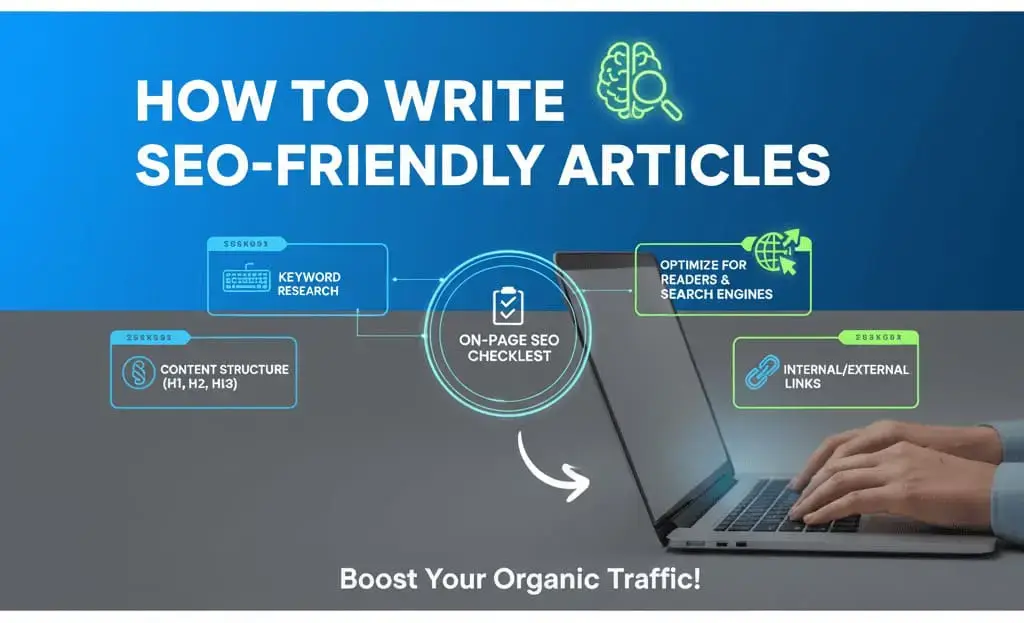What Makes an Article “SEO-Friendly” (Without Keyword Stuffing)
Let’s be clear — SEO writing isn’t about sprinkling keywords like confetti. It’s about writing content that earns visibility because it solves the reader’s problem and helps search engines understand what it’s about.
An SEO-friendly article has three goals:
-
Search Intent Alignment: You understand why people search for that term (informational, transactional, navigational).
-
Keyword Relevance: You use the right words naturally so Google knows the topic.
-
User Experience: You write clearly, structure smartly, and keep readers scrolling — not bouncing.
✅ Quick rule:
If your reader doesn’t notice your keywords but still finds your article insanely useful — you nailed SEO writing.
💡 Want experts to optimize your blogs and landing pages for ranking?
Try our On-Page SEO Services — designed to make your content both search- and reader-friendly.
How to Choose and Place Keywords Naturally
Here’s the formula most beginners skip:
👉 Start with the topic → Research intent → Cluster related terms → Map them across headings.
Example:
Let’s say your core keyword is “how to write SEO article.”
You’ll also find related queries like:
-
SEO writing for beginners
-
keyword placement for SEO
-
SEO article structure
-
how many keywords to use
Now, instead of forcing them in every paragraph, map them where they make sense:
| Section | Keyword | Type |
|---|---|---|
| Title | how to write SEO article | Primary |
| Intro | writing my first SEO article | Emotional hook |
| H2s | SEO article structure, keyword placement for SEO | Supporting |
| FAQ | how many keywords to use | Question/Long-tail |
💡 Pro tip:
Use your main keyword once in:
-
Title
-
First 100 words
-
One H2
-
URL slug
-
Meta description
Everything else? Let it flow naturally in context.
The Perfect SEO Blog Structure (H1–H3 Example)
A great SEO article has a clear hierarchy. Here’s a format you can follow every time:
H1: Writing Your First SEO Article: Step-by-Step Guide
Intro: State what problem the post solves and what readers will learn.
H2: What Makes an Article SEO-Friendly
→ Short explanation, simple checklist
H2: How to Research and Use Keywords
→ Explain with examples, tools, screenshots if possible
H2: SEO Article Structure Example
→ Include H3s like:
-
H3: How to Write an Introduction That Hooks
-
H3: How to Format Subheadings
-
H3: Internal Links & CTA Placement
H2: FAQ – Common Beginner Questions
→ H3: How many keywords to use?
→ H3: Do I need SEO tools for every article?
H2: Final Checklist
→ Quick summary of must-do items before publishing
✅ This structure tells both Google and readers what’s inside your post — and keeps you from writing aimlessly.
How Many Keywords Should You Really Use?
Here’s the truth: there’s no magic number.
But there is a practical balance.
-
Use your main keyword 3–5 times for a 1,500-word article.
-
Sprinkle secondary keywords once or twice each, where they fit naturally.
-
Don’t repeat phrases mechanically — rephrase or use synonyms.
📊 Example:
If your article is 1,200 words, having your main keyword appear 4 times (≈0.3%) is perfectly fine.
If you’re writing 2,000 words, you can stretch to 6–7 mentions.
The focus? Contextual relevance over repetition.
Example Outline for Your First SEO Blog Post
Let’s see how all this looks when put together:
Topic: How to Write an SEO Blog Post
Target Audience: Beginners learning content writing
Word Count: 1,500–1,800
Outline:
-
Intro: Why SEO writing matters (and how it’s different from normal writing)
-
H2: What Makes an Article SEO-Friendly
-
H2: How to Choose Keywords
-
H3: Tools (Google Keyword Planner, Ahrefs, etc.)
-
H3: Understanding Search Intent
-
-
H2: Where to Place Keywords (with examples)
-
H2: How to Structure Your Article (H1–H3 layout)
-
H2: SEO Writing Tips (tone, flow, readability)
-
H2: FAQ – Keyword usage, word count, optimization
H2: Final Checklist (meta tags, links, preview, readability)
You’ve now got a replicable framework for every SEO article — whether it’s about marketing, tech, or fitness.
💼 Want to skip the DIY and get your first SEO article written by pros?
Explore our SEO Content Writing Service — crafted for beginners who want fast, rank-ready content.
Final Checklist Before Publishing
Before hitting “Publish,” go through this quick sanity list:
✅ Keyword in title, URL, intro, and one H2
✅ Meta title & description written manually
✅ Internal link to at least one relevant blog post or service
✅ Featured image optimized with ALT text
✅ Paragraphs under 3 lines
✅ Grammarly or Hemingway score above 80
✅ Mobile preview looks clean
✅ No filler, no AI gibberish — everything sounds human
Final Thoughts
Writing your first SEO article isn’t about chasing an algorithm — it’s about understanding what people are searching for and writing something so helpful that Google wants to rank it.
Keep your tone simple, keywords natural, and structure tight.
Do this for 5–10 posts, and you’ll start to feel how SEO writing works — it becomes instinct.
🔍 Ready to go beyond your first article?
Partner with Marketing Scrappers — Pakistan’s leading SEO experts to build content strategies that attract, rank, and convert.




Pingback: Types of Content Writing: A Comprehensive Guide - Marketing Scrappers
Pingback: 10 Types of Content Writing for a Successful Business - Marketing Scrappers
Pingback: B2B Digital Marketing Benchmarks and trends for 2024: - Marketing Scrappers
Hello! Do you know if they make any plugins to assist with SEO?
I’m trying to get my website to rank for some targeted
keywords but I’m not seeing very good gains. If you know of any please share.
Thank you! You can read similar article here: Warm blankets
Hello Bobby,
Thank you for your comment! Yes, there are several plugins that can greatly assist with SEO and help improve your website’s ranking for targeted keywords. Here are a few popular ones:
Yoast SEO – Excellent for beginners and advanced users, it helps with keyword optimization, readability analysis, and creating SEO-friendly meta descriptions.
Rank Math – A powerful alternative to Yoast, offering features like keyword analysis, schema markup, and more for free.
All in One SEO Pack – A straightforward plugin for managing meta tags, XML sitemaps, and social media optimization.
I also recommend focusing on technical SEO aspects like site speed, mobile responsiveness, and internal linking. Feel free to explore these plugins, and let us know if you have any specific questions!
Pingback: How to Create SEO-Rich Content for Beginners 2025 (Full Guide)